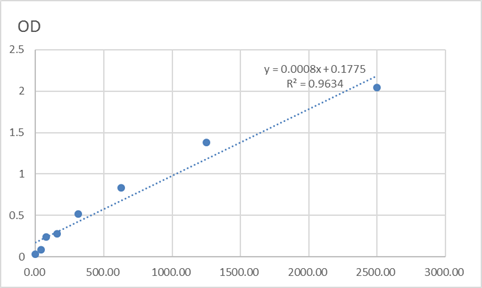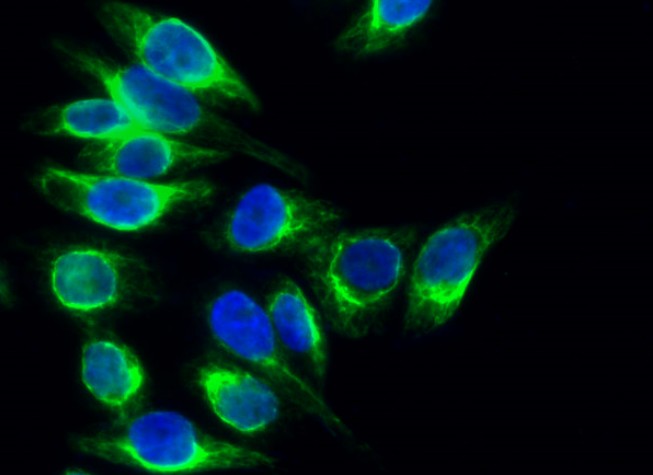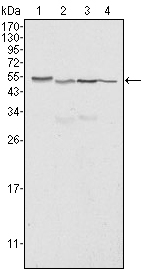Total Calregulin Cell-Based Colorimetric ELISA Kit
- Catalog No.:KA3576C
- Applications:ELISA
- Reactivity:Human;Mouse;Rat
- Gene Name:
- CALR
- Human Gene Id:
- 811
- Human Swiss Prot No:
- P27797
- Mouse Swiss Prot No:
- P14211
- Rat Swiss Prot No:
- P18418
- Storage Stability:
- 2-8°C/6 months
- Other Name:
- Calreticulin (CRP55) (Calregulin) (Endoplasmic reticulum resident protein 60) (ERp60) (HACBP) (grp60)
- Detection Method:
- Colorimetric
- Background:
- caution:Was originally (PubMed:2332496) thought to be the 52 kDa Ro autoantigen.,domain:Associates with PDIA3 through the tip of the extended arm formed by the P-domain.,domain:Can be divided into a N-terminal globular domain, a proline-rich P-domain forming an elongated arm-like structure and a C-terminal acidic domain. The P-domain binds one molecule of calcium with high affinity, whereas the acidic C-domain binds multiple calcium ions with low affinity.,domain:The interaction with glycans occurs through a binding site in the globular lectin domain.,domain:The zinc binding sites are localized to the N-domain.,function:Molecular calcium binding chaperone promoting folding, oligomeric assembly and quality control in the ER via the calreticulin/calnexin cycle. This lectin interacts transiently with almost all of the monoglucosylated glycoproteins that are synthesized in the ER. Interacts with the DNA-binding domain of NR3C1 and mediates its nuclear export.,mass spectrometry: PubMed:11149926,online information:Calreticulin,online information:Calreticulin entry,similarity:Belongs to the calreticulin family.,subcellular location:Also found in cell surface (T cells), cytosol and extracellular matrix. Associated with the lytic granules in the cytolytic T-lymphocytes.,subunit:Monomer. Component of an EIF2 complex at least composed of CUGBP1, CALR, CALR3, EIF2S1, EIF2S2, HSP90B1 and HSPA5. Interacts with PDIA3/ERp57 and with NR3C1.,
- Function:
- negative regulation of transcription from RNA polymerase II promoter, MHC protein complex assembly, MHC class I protein complex assembly, antigen processing and presentation of peptide antigen via MHC class I, peptide antigen assembly with MHC protein complex, peptide antigen assembly with MHC class I protein complex, regulation of DNA replication, regulation of transcription, DNA-dependent, regulation of transcription from RNA polymerase II promoter,regulation of translation, protein folding, protein complex assembly, protein targeting, protein export from nucleus,cellular ion homeostasis, cellular calcium ion homeostasis, cellular metal ion homeostasis, intracellular protein transport, nucleocytoplasmic transport, cytoskeleton organization, cell cycle, cell cycle arrest, intracellular signaling cascade, aging, protein localization, positive regulation of cell proliferation, negative re
- Subcellular Location:
- Endoplasmic reticulum lumen . Cytoplasm, cytosol . Secreted, extracellular space, extracellular matrix . Cell surface . Sarcoplasmic reticulum lumen . Cytoplasmic vesicle, secretory vesicle, Cortical granule . Cytolytic granule . Also found in cell surface (T cells), cytosol and extracellular matrix (PubMed:10358038). During oocyte maturation and after parthenogenetic activation accumulates in cortical granules. In pronuclear and early cleaved embryos localizes weakly to cytoplasm around nucleus and more strongly in the region near the cortex (By similarity). In cortical granules of non-activated oocytes, is exocytosed during the cortical reaction in response to oocyte activation (By similarity). .
- June 19-2018
- WESTERN IMMUNOBLOTTING PROTOCOL
- June 19-2018
- IMMUNOHISTOCHEMISTRY-PARAFFIN PROTOCOL
- June 19-2018
- IMMUNOFLUORESCENCE PROTOCOL
- September 08-2020
- FLOW-CYTOMEYRT-PROTOCOL
- May 20-2022
- Cell-Based ELISA│解您多样本WB检测之困扰
- July 13-2018
- CELL-BASED-ELISA-PROTOCOL-FOR-ACETYL-PROTEIN
- July 13-2018
- CELL-BASED-ELISA-PROTOCOL-FOR-PHOSPHO-PROTEIN
- July 13-2018
- Antibody-FAQs



